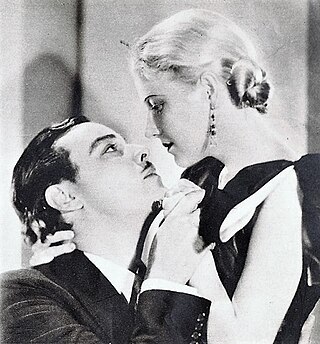
Gene Stratton-Porter, born Geneva Grace Stratton, was an American writer, nature photographer, and naturalist from Wabash County, Indiana. In 1917 Stratton-Porter urged legislative support for the conservation of Limberlost Swamp and other wetlands in Indiana. She was also a silent film-era producer who founded her own production company, Gene Stratton Porter Productions, in 1924.

Virginia Anna Adeleid Weidler was an American child actress, popular in Hollywood films during the 1930s and 1940s.

A Girl of the Limberlost, a novel by American writer and naturalist Gene Stratton-Porter, was published in August 1909. It is considered a classic of Indiana literature. It is the sequel to her earlier novel Freckles.

The Youngest Profession is a 1943 film directed by Edward Buzzell, and starring Virginia Weidler, Edward Arnold, John Carroll, Scotty Beckett, and Agnes Moorehead. Based on a short story series and book written by Lillian Day, it contains cameos by Greer Garson, Lana Turner, William Powell, Walter Pidgeon, and Robert Taylor.

Double Harness (1933) is an American pre-Code film starring Ann Harding and William Powell. It was based on the play of the same name by Edward Poor Montgomery. A young woman maneuvers a lazy playboy into marrying her.

Romance of the Limberlost is a 1938 American drama film directed by William Nigh and starring Jean Parker, Eric Linden, and Marjorie Main.

RKO Radio Pictures's Laddie is a 1940 American drama film starring Tim Holt, Virginia Gilmore and Joan Carroll and directed by Jack Hively. It is the third film adaptation based on Gene Stratton-Porter's novel, Laddie, A True Blue Story (1913), and previously had been filmed in 1926 and by RKO in 1935.

The Right to Romance is a 1933 American pre-Code drama film starring Ann Harding and Robert Young and released by RKO Radio Pictures.

The Gene Stratton-Porter Cabin, known as the Cabin at Wildflower Woods and the Gene Stratton-Porter State Historic Site, is the former home of Gene Stratton-Porter, a noted Indiana author, naturalist, and nature photographer. The two-story, fourteen-room cabin, which was built in 1914, is located at Sylvan Lake near Rome City in Noble County, Indiana. Stratton-Porter lived full-time in the cabin from 1914 through 1919, then relocated to homes in California, where she continued to write and founded a movie studio. She returned to Wildflower Woods in Rome City for brief visits until her death in 1924. The property was listed on the National Register of Historic Places in 1974.

Dangerous Corner is a 1934 American mystery film directed by Phil Rosen, using a screenplay by Anne Morrison Chapin, Madeleine Ruthven, Ralph Berton, and Eugene Berton, which was based on a novel and play of the same name by J. B. Priestley. It starred Virginia Bruce, Conrad Nagel, and Melvyn Douglas.

Freckles is a 1935 American drama film directed by Edward Killy and William Hamilton from a screenplay written by Dorothy Yost, adapted by Mary Mayes from Gene Stratton-Porter's 1904 novel of the same name. Two earlier adaptations of Stratton-Porter's novel had been produced, the first by Paramount in 1917, and the second in 1928 by FBO, both were also titled Freckles. This 1935 version was released by RKO Radio Pictures on October 4, and stars Tom Brown, Virginia Weidler, and Carol Stone.
Three Sons is a 1939 American drama film directed by Jack Hively using a screenplay by John Twist, based on the novel, Sweepings by Lester Cohen. Produced and distributed by RKO Radio Pictures, and released on October 13, 1939, it is a remake of an earlier RKO film, Sweepings (1933). The film stars Edward Ellis, William Gargan, J. Edward Bromberg and Robert Stanton. Gargan, who plays the uncle in this film, had played one of the sons in the earlier film.

I'll Wait for You is a 1941 American drama film directed by Robert B. Sinclair and written by Guy Trosper. The film stars Robert Sterling, Marsha Hunt, Virginia Weidler, Paul Kelly, Fay Holden and Henry Travers. A re-make of the 1934 film Hide-Out, it was released on May 16, 1941, by Metro-Goldwyn-Mayer.

Gene Stratton-Porter Cabin, , known as the Limberlost Cabin and the Limberlost State Historic Site, was the former home of Gene Stratton Porter, a noted Indiana author who lived in the home from 1895 to 1913. The two-story, fourteen-room log cabin is located near the Limberlost Swamp on the outskirts of Geneva in Adams County, Indiana. Stratton-Porter designed the Queen Anne-style rustic home with the help of an architect. It was listed on the National Register of Historic Places in 1974.

The Harvester is a 1936 American comedy film directed by Joseph Santley and written by Homer Croy, Robert Lee Johnson, Elizabeth Meehan and Gertrude Orr. It is based on the 1911 novel The Harvester by Gene Stratton-Porter, which had previously been turned into a 1927 silent film of the same title. The film stars Alice Brady, Russell Hardie, Ann Rutherford, Frank Craven, Cora Sue Collins and Emma Dunn. The film was released on April 18, 1936, by Republic Pictures.

The Girl of the Limberlost is a 1945 American drama film starring Ruth Nelson, Dorinda Clifton, and Loren Tindall, and directed by Mel Ferrer. The film is based on a 1909 novel by Gene Stratton-Porter, which was previously filmed in 1909 as "A Girl of the Limeberlost".

Laddie is a 1926 American silent drama film directed by James Leo Meehan with John Bowers in the title role. It was based on Gene Stratton-Porter's novel, Laddie, A True Blue Story (1913).

James Leo Meehan was an American film director and screenwriter. He married the daughter of writer Gene Stratton-Porter, and adapted several of his mother-in-law's novels for the screen.
A Girl of the Limberlost is a 1924 American silent film, produced by Gene Stratton-Porter and directed by James Leo Meehan. It stars Gloria Grey, Emily Fitzroy, and Arthur Currier, and was released on April 28, 1924. The first adaptation of Stratton-Porter's famous novel, this silent film is considered lost.



















